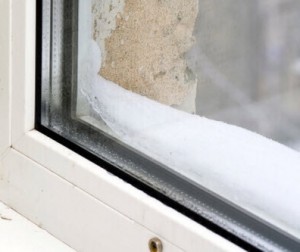There is nothing like a fresh snowfall or gathering around the fireplace during the holidays and marveling at the frost that forms on our windows. But as beautiful as nature is, it is equally destructive. The cold that bites at the exterior of our houses clashes with the warm air in the interior of our homes and furnaces, and this can ultimately cause mold to form on our windows. The largest giveaway or red flag that shows you potentially have a mold problem is called window sweat – which is moisture that collects on your windows and makes them look foggy. Allowing stagnate moisture to stay on your windows creates the perfect environment for mold spores to grow, but what causes window sweat in the first place?

The Condensation Process
The process is actually pretty simple and straightforward. Believe it or not, even top quality windows fall victim to this process as well. It all begins with the convection cycle. You see, your windows are exposed to extremely cold air on the exterior of your home and warm air on the interior of your home. As the warm air in your home comes into contact with your window, it cools and sinks. Then warm air replaces the cooled air, and the cycle continues. But the problem is that as the warm air cools on the surface of your window, it can leave moisture behind when the air cools below the dew point. Over time, so much moisture accumulates on the glass that it becomes visible. And as we all know, stagnate moisture gives mold the opportunity it needs to ruin your home.
Window Replacement
But what do you do to combat this problem? Do you simply keep a towel handy to continually dry your windows? Well, that really isn’t a viable option. Window sweat is a long term problem, and you need to fix the root problem, not just the symptoms. Your best option is really to replace your windows. When you are looking at replacing a window, there is a critical metric that you need to be concerned with called the CRF (Condensation Resistance Factor) score that was created by the NFRC (National Fenestration Rating Council). This numeric value ranges from 1 to 100, and the higher the number, the more resistant that window is to moisture. You can usually find this value on a sticker when you are window shopping.
Though purchasing a new window may not be the most exciting use of your money, you need to ask yourself an important question. Is it worth the risk of not replacing your windows and allowing mold to take over your home? Remember that mold can snowball out of control, and even a tiny bit of mold is a serious problem. There are techniques that can be used after mold has taken over your home such as mold remediation, but you are far better off avoiding the problem altogether. As they say, an ounce of prevention is worth a pound of cure.
Mold Detection and Removal Services
If you have discovered that mold is growing on your windows, contact Andrew Roto Services, Inc. Not only can we help identify other areas where mold may be growing, but we can also help with our mold remediation services.



Leave a Reply